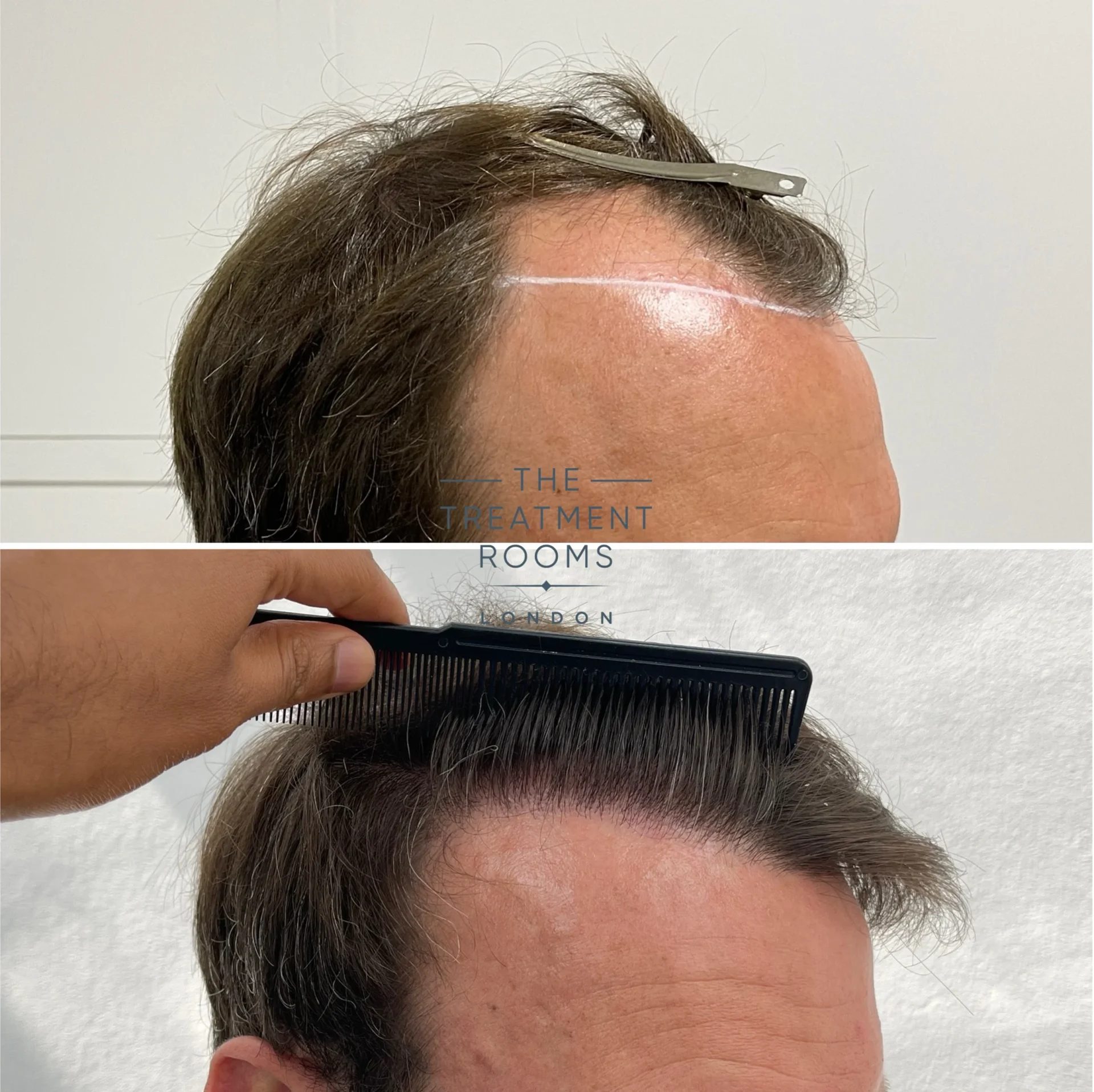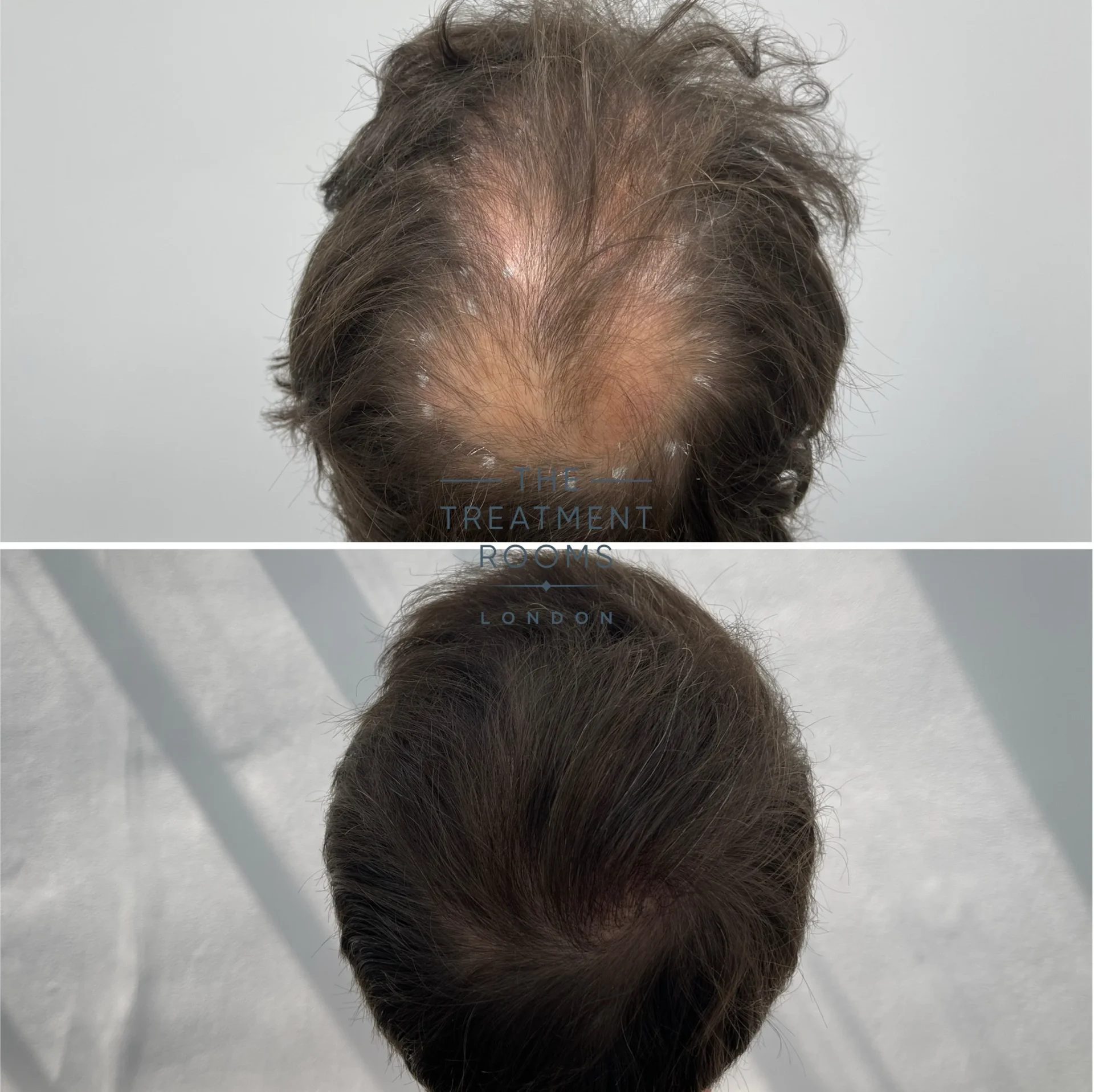When trying to resolve issues related to hair loss, many people will often try a number of different treatment options.
One of the most popular choices of hair loss treatments is Minoxidil – a medication originally designed to treat hypertension (high blood pressure) which was later found to promote hair growth1.
However, while Minoxidil can offer a great, scientifically-backed method of slowing hair loss, there are various reasons why you might consider stopping using it.
Understanding Minoxidil
Before we get into why you might decide to stop using Minoxidil, it is important to first understand what it is and how it works.
Originally developed as an antihypertensive medication, Minoxidil was found to have an unexpected side effect – promoting hair growth1.
While the exact mechanism of action remains relatively unknown, Minoxidil has been theorised to work by opening blood vessels in the scalp and allowing more blood flow to the hair follicles. This action then enhances the delivery of nutrients and encourages hair to regrow.
In research, clinical studies have shown patients with androgenetic alopecia experience remarkable increases in hair growth and a decrease in hair loss when using Minoxidil, with many users often reporting positive results in testimonials2.
Effects while using Minoxidil
When adopting Minoxidil as part of a daily routine, many individuals experience positive changes in terms of both hair growth and lifestyle. For example, these often include:
- Increased hair density and thickness
- Reduced hair loss
- Fuller appearance of hair
- Improved confidence and mental wellbeing
- More control over their hair loss
However, it’s important to note that individual responses to Minoxidil can vary.
While some users may witness significant regrowth, for example, others may observe more modest results, depending on factors like genetics, the underlying cause of hair loss, and how consistently the solution is applied on a daily basis.
Reasons for stopping Minoxidil
While Minoxidil is an effective hair loss treatment, there are a variety of reasons why someone might decide to stop using it. These might include3:
- Unexpected results – if you’re not achieving the hair growth results you expected, you might decide to change to another type of hair loss treatment.
- Side effects – for some people, Minoxidil can cause certain side effects like skin irritation, leg swelling, weight gain and chest palpitations that can impact their day-to-day life.
- Cost of use – since Minoxidil requires daily use, the costs can rack up over time, making it expensive to continue using every day.
- No longer required – if you manage to achieve the results you wanted to get, you may think you no longer need to take Minoxidil.
However, before you decide to stop taking Minoxidil, it’s crucial to understand the potential consequences of doing so.
The potential effects after stopping Minoxidil
Since Minoxidil doesn’t address the root cause of hair loss, stopping its use could gradually reverse the positive effects you’ve experienced.
After discontinuing minoxidil, your natural hair growth cycle resumes. Since Minoxidil works by prolonging the anagen (growth) phase of the hair growth cycle and shortening the telogen (shedding) phase4, stopping its use can lead to increased hair shedding, returning to your previous pattern of hair loss.
This hair shedding won’t occur straight away either – any side effects you encounter while taking it should wear off within a few days once you stop, but the hair-shedding process may start three to six months later1.
Therefore, it’s essential to manage expectations during this phase, understanding that the effects of minoxidil may not be permanent.
Managing changes after stopping Minoxidil
Managing the changes in hair growth that you are likely to encounter when discontinuing Minoxidil will require two key elements: a proactive approach and careful planning.
Here are some of the key strategies you will need to consider:
- Learn about the natural hair growth cycle – Hair goes through cycles of growth, rest and shedding. Understanding this natural progression can help manage expectations and recognise that changes in hair density are a normal part of the process.
- Maintain a healthy lifestyle – a balanced diet, regular exercise and proper stress management all contribute to your overall health, which can, in turn, impact the condition of your hair. Ensuring your body receives essential nutrients from your diet is crucial for maintaining a healthy head of hair.
- Consider alternative treatments – if you’d like to counteract the hair-shedding effect of stopping Minoxidil, explore alternative hair loss treatments, such as Finasteride or FUE hair transplant surgery. By doing your research, you may be able to find an alternative non-surgical solution better suited to your type of hair loss.
One of the best ways to prepare for stopping Minoxidil is by consulting an expert. They will be able to answer any questions you might have, providing you with tailored advice to ensure that deciding to stop is the right choice for you.
Hair Transplants instead of Minoxidil?
If you are thinking of stopping Minoxidil due to limited results or for any other personal reason, it might be worth considering having a hair transplant.
The procedure can give permanent results, growing back your full natural hairline or crown within 12 months. However, it is important to note that stopping Minoxidil increases the risk of future hair loss, which could impact your hair transplant result and its longevity.
At Treatment Rooms London, we have helped hundreds of patients achieve their plan for a new hairline or crown with our expert and highly renowned surgeons leading every procedure.
As a patient-first clinic, we continue to provide premium hair transplants to our patients from London to Bristol, to Oxford and across the UK. We also serve patients from outside the UK, with more people from Dubai and the USA taking advantage of our world-class hair transplant surgical techniques.
Why Choose a Hair Transplant?
As you know, Minoxidil requires continuous application to achieve and maintain results, while hair transplant surgery offers a permanent solution to hair loss.
Once the transplanted hair follicles settle and begin to grow, the results can last a lifetime, making this a great option if you are looking to restore hair loss..
Here are a few key benefits:
- Permanent and natural-looking results
The new hair follicles will grow and blend naturally into the rest of your hair, making the result hardly detectable - Low-maintenance
After recovery, the new hair does not need any special maintenance or treatment outside your regular hair care routine. - One-time procedure with lasting impact
While Minoxidil requires daily commitment, a hair transplant is typically a one-time treatment with results lasting up to 25 years.
Beyond Minoxidil: Hair Transplant Transformations from Our Clinic



Seek specialist advice at The Treatment Rooms London
Stopping taking Minoxidil is a big decision that requires careful thought and planning. As such, understanding the potential effects, changes in hair growth and associated risks that stopping it can bring is imperative, especially when trying to manage expectations.
Here at The Treatment Rooms London, our team is composed of highly experienced healthcare professionals who are always on hand to offer specialist advice.
We understand that each individual’s hair loss journey is incredibly unique, so we will work with you to find the best solution for your needs, taking into account factors like cost, your medical history and the long-term results you are hoping to achieve.
To get started, simply book a consultation with us and we’d be more than happy to help.
Sources
- Suchonwanit, P., Thammarucha, S. & Leerunyakul, K. (2019) Minoxidil and its use in hair disorders: a review. Drug Des Devel Ther. 13: 2777 – 2786. Available at: https://www.ncbi.nlm.nih.gov/pmc/articles/PMC6691938/
- Price V., Menefee E. & Strauss P. (1999) Changes in hair weight and hair count in men with androgenetic alopecia, after application of 5% and 2% topical minoxidil, placebo, or no treatment. J Am Acad Dermatol. 41(5 Pt 1): 717 – 721. Available at: https://pubmed.ncbi.nlm.nih.gov/10534633/
- Shadi, Z. (2023) Compliance to Topical Minoxidil and Reasons for Discontinuation among Patients with Androgenetic Alopecia. Dermatol Ther (Heidelb). 13(5): 1157 – 1169. Available at: https://www.ncbi.nlm.nih.gov/pmc/articles/PMC10149432/
- Patel, P. Nessei, T. & Kumar, D. (2023) Minoxidil. In: StatPearls [Internet]. Treasure Island (FL): StatPearls Publishing. Available at: https://www.ncbi.nlm.nih.gov/books/NBK482378/
Share:
Authored by
Reviewed by
Book a Consultation
Related Blogs
Complete Guide on Folic Acid and Hair Loss
July 9, 2025
Quick Summary Hair loss is a widespread concern that affects millions of people globally. While genetics, hormonal…
Does Hair Dye Cause Hair Thinning? Understanding the Risks and Facts
July 8, 2025
Have you noticed more hair loss after dyeing your hair? The ingredients in some dyes can be…
When Can You Safely Wear a Beanie After a Hair Transplant?
July 3, 2025
Quick Summary Cap Recommendations: Light, breathable caps, such as snapbacks or trucker hats, are advisable if you need…
Castor Oil (Ricino Oil) for Hair Growth: Benefits, Uses & How to Apply for Maximum Results
June 26, 2025
Castor oil, also known as Ricino oil, is extracted from the Castor bean plant (Ricinus communis). During…
What is a Hair Transplant? How it Works, Success Rate & What to Expect
June 23, 2025
Hair transplantation is a cosmetic surgical procedure that restores hair by moving healthy follicles from one part…
John Cena Hair Transplant
May 14, 2025
John Cena, a common household name, is a figure who has effortlessly straddled the worlds of professional…
Kyle Walker Hair Transplant: Before, After, and His New Hairline
May 12, 2025
Kyle Walker is known for his defensive skills at Tottenham Hotspur, Manchester City, and in the England…
Celebrity Hair Transplants: Full Before and After Analysis
May 8, 2025
Elon Musk Hair Transplant Elon Musk, the billionaire behind Tesla and SpaceX, is well-known for his innovations…
Lewis Hamilton Hair Transplant: Before, After, and His New Hairline
May 7, 2025
As a top-class racing driver, Hamilton is used to wearing a race helmet. While this does protect…











